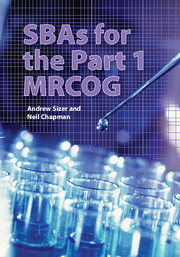Book contents
- Frontmatter
- Contents
- Preface
- About the authors
- Acknowledgements
- Abbreviations
- Foreword
- How to use this book
- 1 Structure and content of the Part 1 MRCOG examination
- 2 Part 1 MRCOG blueprinting matrix, syllabus topics and example questions for paper 1
- 3 Part 1 MRCOG blueprinting matrix, syllabus topics and example questions for paper 2
- 4 Mock paper: paper 1
- 5 Mock paper: paper 2
- Appendix 1 Blueprinting matrix for the Part 1 MRCOG examination
- Appendix 2 Example SBA answer sheet
- Appendix 3 Answers to chapter 2 questions
- Appendix 4 Answers to chapter 3 questions
- Appendix 5 Answers to mock paper 1 (chapter 4)
- Appendix 6 Answers to mock paper 2 (chapter 5)
2 - Part 1 MRCOG blueprinting matrix, syllabus topics and example questions for paper 1
Published online by Cambridge University Press: 05 July 2014
- Frontmatter
- Contents
- Preface
- About the authors
- Acknowledgements
- Abbreviations
- Foreword
- How to use this book
- 1 Structure and content of the Part 1 MRCOG examination
- 2 Part 1 MRCOG blueprinting matrix, syllabus topics and example questions for paper 1
- 3 Part 1 MRCOG blueprinting matrix, syllabus topics and example questions for paper 2
- 4 Mock paper: paper 1
- 5 Mock paper: paper 2
- Appendix 1 Blueprinting matrix for the Part 1 MRCOG examination
- Appendix 2 Example SBA answer sheet
- Appendix 3 Answers to chapter 2 questions
- Appendix 4 Answers to chapter 3 questions
- Appendix 5 Answers to mock paper 1 (chapter 4)
- Appendix 6 Answers to mock paper 2 (chapter 5)
Summary
This chapter and chapter 3 break down the blueprinting matrix into individual components and provide example questions where appropriate.
Not all module and domain intersections on the matrix have a relevant syllabus subject area; for example, there are no syllabus topics for the Part 1 examination combining core module 3 (IT, governance and research) and the embryology domain. On the other hand, other syllabus areas may appear on the grid more than once.
The list of syllabus topics given here is not exhaustive. Obstetrics and gynaecology is a continually evolving subject and new knowledge is appearing all the time. Likewise, the Part 1 examination is also continually evolving. It is therefore wise to always consult the RCOG website (www.rcog.org.uk) for the most up-to-date syllabus and examination information.
Answers to the questions in this chapter can be found in appendix 3.
Anatomy domain
Core modules 5-7
Syllabus topics: Surgical anatomy of the pelvis and abdomen. Detailed functional anatomy of abdominal wall, abdominal cavity and pelvis, their contents, relevant bones, joints, muscles, blood vessels, lymphatics, nerve supply and histology. Understanding of breast and endocrine gland anatomy. Organisation and structure of the cell and its organelles. Classification systems for gynaecological and obstetric conditions.
SBA 1
During a caesarean section, the rectus sheath is divided to reveal the rectus muscle. The combined aponeuroses of which muscles form the anterior component of the rectus sheath?
A External and internal oblique
B External oblique and transversus abdominis
C Internal oblique and transversus abdominis
D Pyramidalis and serratus anterior
E Pyramidalis and transversus abdominis
- Type
- Chapter
- Information
- SBAs for the Part 1 MRCOG , pp. 7 - 34Publisher: Cambridge University PressPrint publication year: 2012



